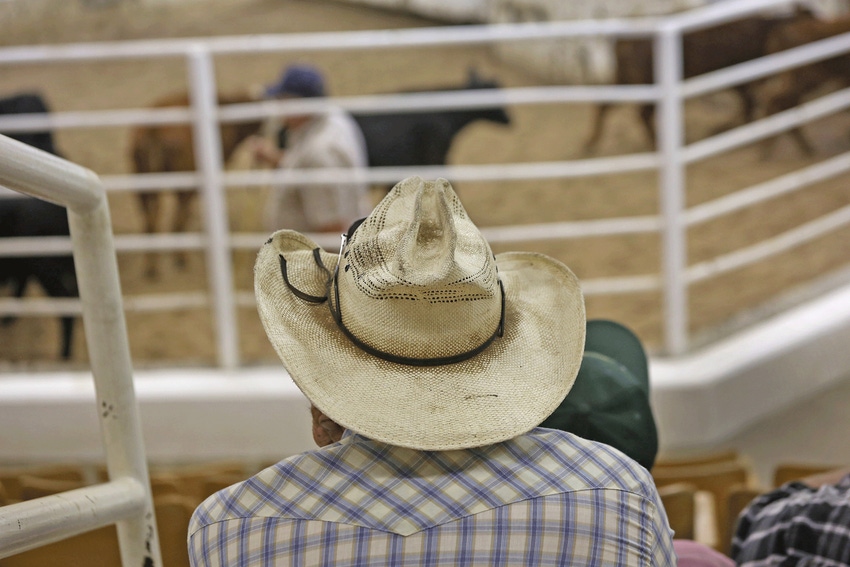Steady as she goes; Long-term ag projections say stable to slow growth
What will calves and feeder cattle fetch five years from now? Ten years? That depends on a lot of things, but two different outlooks took all the factors into consideration and came up with very different conclusions.
March 30, 2018

“Cattle and hog prices are projected to resume annual declines in 2018 and 2019, as large supplies continue to enter the market. Price declines were interrupted in 2017 due to very strong meat demand,” say analysts with the Food and Agricultural Policy Research Institute (FAPRI) at the University of Missouri, in that organization’s annual U.S. Baseline Outlook. “While economic projections point to U.S. meat demand remaining solid, prices are projected to retreat for most products in 2018 due to continued supply pressure and a return to more historical levels of consumer demand.”
“Favorable returns at the start of the projection period and robust demand provides incentives for continued growth of the U.S. livestock sector over the next 10 years,” according to USDA Agricultural Projections to 2027. “In the beef cattle industry, the feed price ratios are expected to decline over the projection period, reflecting lower cattle prices and suggesting lower returns to production.”
These annual 10-year projections are based on different assumptions and models. They’re prepared heading into January, when current year-end numbers are unavailable. Both suggest stable to slow growth in domestic agricultural production. However, each paints vastly different price trends for cattle and beef.
Here’s the outlook
FAPRI projects cattle prices to bottom out in the next couple of years and then gradually increase for the remainder of the projection period. For example, FAPRI projects the low fed steer price at $110.15 per cwt in 2020, with a high of $132.41 in 2027. The low for feeder steer prices (600 to 650 pounds, Oklahoma City) is projected at $138.34 per cwt in 2020, with a high of $183.42 in 2027.
FAPRI pegs net cow-calf returns at $44.99 per cow this year, declining to -$16.64 in 2020 and then increasing steadily to $133.50 in 2027.
“Consumer demand for meat was stronger than average in 2017. It is rare for meat supplies to grow as they did last year without output prices suffering more severe declines,” according to FAPRI analysts. “Strong demand supported cattle, hog, chicken and milk prices in 2017 in the face of large increases in meat and milk production. Further production increases could weigh on livestock and dairy prices in 2018 unless demand growth is exceptionally strong.”
USDA sees cattle prices declining throughout the next 10 years. USDA projects the low fed steer price at $97.13 per cwt in 2027, with the period high this year, then declining. Likewise, the highest feeder steer price (Oklahoma City, 750 to 800 pounds) is projected for this year, then declining to a low of $104.94 in 2027. USDA projects calf prices at the farm of $167.29 this year, declining to $121.92 in 2027.
“Reduced feed costs over the past several years have improved livestock-sector net returns, providing economic incentives for expansion,” explain USDA analysts. “Nominal prices for beef cattle are projected to decline through most of the next decade as production rises … both domestic and global demand for meats and dairy products are expected to remain strong. Despite the lower expected returns, red meat and poultry production all increase over the projection period.”
Total estimated beef production is one reason behind the stark difference between the two price outlooks.
USDA projects beef production at 27.6 billion pounds this year, the lowest of the decade, and then says it will meander to 29.1 billion pounds in 2027. FAPRI estimates beef production of 27.5 billion pounds this year, growing to 28.5 billion in 2020 and then declining gradually to 28.2 billion in 2027.
That’s with a fairly stable beef cow inventory, in historic terms — one capable of sustaining current feedlot and beef-packing capacity. The nation’s beef cow herd likely needs to be at or above 31 million cows or so over the long haul to maintain infrastructure, according to Sterling Liddell, senior analyst of data analytics for RaboBank’s RaboResearch Food and Agribusiness.
USDA projects the beef cow inventory to peak at 32.2 million head next year, and then gradually decline by 900,000 head to 31.3 million by 2027. FAPRI has the beef cow inventory peaking at 32 million in 2019, and then gradually declining 2 million head to 30 million head in 2027.
More people and money
The backdrop for both outlooks includes projected domestic and global economic growth, albeit slow growth overall, with the most rapid growth in emerging economies.
USDA projects global real economic growth to average less than 3% annually over the next decade. Growth in developed countries is estimated at 1.7% annually (2.1% for the U.S.), with about 4.6% annual growth in developing countries. In terms of population, USDA projects the global population at 7.37 billion in 2017, growing by 673 million over the next decade.
Incidentally, the folks at FAPRI explain food price inflation last year was less than 1% for the second consecutive year — the first time it had grown less than 1% in consecutive years since 1955-56.
“In the baseline, the average rate of increase in consumer food prices is 2.4% per year, almost identical to the rate of increase in the general consumer price index,” say FAPRI analysts.
“Steady global economic growth supports longer-term gains in world food demand, global agricultural trade and U.S. agricultural exports,” USDA analysts explain. “Economic growth in developing countries is especially important because food consumption and feed use are particularly responsive to income growth in those countries, with movement away from traditional staple foods and towards increased diet diversification, including greater protein consumption.”
More international meat demand
“Per capita beef disappearance (domestic) is expected to increase in the first years of the projection period, followed by a mild downward trend in the later years, flattening out by the end of the decade at levels higher than those seen in the beginning of the projection period,” according to the USDA outlook.
USDA estimates per capita beef disappearance at 59.2 pounds (retail weight) this year, increasing to 60.9 pounds in 2020 and then declining to 59.0 pounds by 2025.
FAPRI estimates per capita domestic beef consumption at 58.7 pounds (retail weight) this year, increasing to 59.4 pounds in 2020 and then declining to 56.4 pounds in 2027, about what it was last year.
Competing protein production is projected to continue growing, too.
USDA estimates per capita total red meat and poultry disappearance (retail weight) at 222.2 pounds this year, increasing to 224 pounds in 2020 and then declining to 221.5 pounds by 2027.
FAPRI projects per capita total red meat and poultry consumption at 218.7 pounds this year, growing to 220.5 pounds in 2020, declining to 219.3 pounds in 2024 and then edging higher to 220.2 pounds in 2027.
That’s one reason international markets remain so important.
USDA estimates U.S. beef exports at 2.97 billion pounds this year, declining to 2.73 billion pounds in 2020 and then increasing to 2.98 billion pounds by 2027.
FAPRI projects beef export this year at 2.98 billion pounds this year, increasing to 3.25 billion pounds in 2021 and then decreasing to 3.09 billion pounds in 2027.
“Growth in global agricultural production is sufficient to meet growing global demand and sustain commodity prices throughout the projection period, but still at relatively low prices, especially compared to prices in 2011 and 2012,” say USDA analysts. “Agricultural production increased due to both yield growth and expansion into new areas of cultivation.”
This is especially true in Brazil, with expanding new area as well as increasing crop yields due to the introduction of new technologies. “Agricultural production is projected to increase more rapidly than world population growth, enabling an increase in per capita use of most agricultural products. Together, these trends result in modest increases in the nominal prices of agricultural commodities throughout the projection period, but in real (inflation-adjusted) terms, global prices fall slightly.”
What will calves and feeder cattle fetch five years from now? Ten years? That depends on a lot of things, but two different outlooks took all the factors into consideration and came up with very different conclusions.
Other FAPRI and USDA projections
Interest costs rise faster than the general inflation rate over the next 10 years, according to USDA, reflecting rising farm debt levels as well as increasing interest rates.
“The average value of farm real estate increased by 47% between 2009 and 2017,” according to the Food and Agricultural Policy Research Institute (FAPRI) at the University of Missouri. “Projected cropland rental rates are fairly steady, but the average value of farm real estate declines slightly between 2017 and 2021 as interest rates increase. Real estate accounts for more than 80% of total farm assets.”
FAPRI projects prices for corn, soybeans and wheat to increase slightly in 2018-19 and 2019-20, limited by bountiful global stocks. FAPRI projects average corn prices at $3.57 per bushel for the 2018-19 crop, with soybean prices at $9.38 and wheat at $4.89.
USDA projects the farm corn price at $3.30 per bushel for 2018-19 and then increasing gradually for the rest of the decade to $3.60 in 2027-28. Prices for the next four years are projected at $3.35, $3.35, $3.40 and $3.40, respectively.
FAPRI expects prices for dried distillers grains (DDGs) to recover slightly this year and then continue following corn prices higher. Over the course of the projection period, DDGs prices are near parity with corn, at $131 per ton on average.
About the Author(s)
You May Also Like




.png?width=300&auto=webp&quality=80&disable=upscale)
